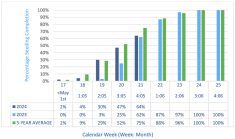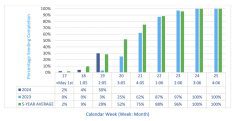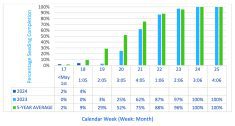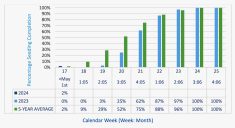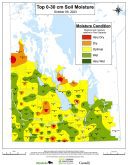Southwest Region
A much-needed rain received across the Southwest this past week. Most areas reported 25 mm or more. Hamiota, Miniota, Newdale, and Rivers reported 25 to 35 mm. Ninette, Souris, and Lenore reported 40 to 60 mm. Daytime temperatures have improved and this will benefit growth; however overnight temperatures still reaching single digit lows.
Seeding of all crops is 100 per cent complete. Canola recovering from insect damage, however late seeded canola just emerging. Early seeded canola is starting to cabbage out. Most first pass weed control is complete and producers have begun second pass in certain crops. Winter cereals are heading out, but crop is shorter than normal. Recent rainfall will help head development. Cereal crops staging varies depending on seeding date. Most fields are now tillering and first leaf node is visible in the main stem. Most crops have had herbicide applied. There are ongoing reports of cutworms doing damage to cereals, corn and canola. Soybeans have benefitted from recent rainfall. Most fields are in the unifoliate to first trifoliate stage with some fields having first pass of herbicide applied.
Read Also

Thunderstorms and straight-line winds
Straight-line winds in thunderstorms can cause as much damage as a tornado and are next on our weather school list exploring how and why severe summer weather forms.
Peas are doing well and are 9 to 10 inches tall. No major issues to date. Sunflowers and corn are established and growing slowly due to persistent cool conditions.
Pastures will benefit from recent rainfall, however pasture that were overgrazed in 2018, still slow to rebound. More rain is required along with warmer weather. Recent rainfall will help hay land and younger stands will probably benefit the most. Older stands will need more rain and time and this rain may have occurs soon enough to help boost first cut yields. Dugouts are about 60 to 70 per cent full.
Northwest Region
Generally good growing conditions in the Northwest last week with daytime temperatures over 25 C. However, nighttime temperatures continued to dip down near zero overnight. Rainfall amounts were minimal through most of the region with the exception the Roblin area, where rainfall amounts ranged from 13 to 39 mm, decreasing moving eastward toward Grandview. This has helped things to green up almost immediately in that area. The remainder of the region is looking for rain, as drying winds continue to worsen soil moisture conditions. Soil moisture conditions around Dauphin/Ste. Rose areas are short/dry; Swan River area soil moisture is rated as adequate (40 per cent), to short (50 per cent) to very short (10 per cent); Roblin soils are adequate (90 per cent) to short (10 per cent); soil moisture at The Pas is 100 per cent adequate.
There was noticeable growth in the canola this week, especially where rainfall occurred. The canola crop is emerged and is at the cotyledon stage with the earlier seeded fields in the early rosette state. Canola continues to appear patchy where soil moisture is a concern with the effects most noticeable on the later seeded crops. Cereals are in the seedling stage with winter wheat at flag leaf and fall rye is heading out. Weeds are actively growing and herbicide applications continue as crops develop and weeds become an issue.
Diamondback moth trap counts counts of around 300 in the Bowsman area. Bertha Armyworm moth trap monitoring has begun. There are reports of multiple spraying operations as flea beetles and cutworm feeding continues. Generally, crops in the Northwest region are rated as good but some canola fields are in very poor condition due to a combination of insect feeding, frost and delayed emergence from dry soils.
Predicted hay yields are very low to zero, with older fields reporting no new growth for cutting. Dugout levels are dropping rapidly in pastures in the Dauphin – Ste. Rose area. Water sources will be a major concern without additional moisture. Most cattle are now on pasture and with no additional precipitation, and are predicted to have a very short grazing season.
Central Region
Dry conditions prevailed at the beginning of the week, which changed on the weekend when conditions cooled to below normal and variable precipitation received. Rain amounts varied from 5 mm in the Austin to Portage to Plumas area to as high as 45 mm in the Cartwright area. The south and western side of the region received the highest amounts. The east and north central portions could use significantly more rain.
Wheat, oats and barley have good establishment and are growing well, in the 4 to 6 leaf stage with some advanced fields at flag leaf emergence. Cereals are tillering well and are most advanced in the Red River Valley. Corn has emerged relatively well and growing at a moderate pace but is considered behind normal development to date. Warmer temperatures would help stimulate growth of this crop.
Overall seeding is considered done including reseeded canola fields that suffered damage from flea beetles, frost or soil blasting from the recent high winds. Spraying for flea beetles is slowing as canola is advancing in size and is outgrowing feeding pressure, but the threat is still present. Canola is most advanced in the Red River Valley and the earliest planted fields are starting to bolt.
Diamondback moth traps were set up, but with none reported above the escarpment. They are in traps in the Red River Valley in increasing numbers. Bertha armyworm traps set up as well. Grasshoppers are becoming a new threat in the eastern part of the Red River Valley given the drier conditions that have allowed many eggs to hatch.
Potato are now emerging after delays due to cold soils at planting. Some field irrigation started, to maintain soil moisture and support growth.
Field peas are moving past the 5 to 7 node stage. Soybeans are emerged and moving into the first trifoliate stage. Soybeans are in need of warmer temperatures to stimulate growth. Soybeans and dry beans on sandy soils had issues last week with the strong winds that damaged and in severe cases buried the plants. Most wind-damaged fields were left to recover but a few soybean fields in Carman/Winkler region were replanted.
Weed growth has been slow due to the early season dryness, and lamb’s quarters are proving challenging to kill. Spraying is continuing with first pass applications well underway with 60 to 70 per cent done. A second pass herbicide application will occur mostly on late maturing crops over the next week or two. Fall rye
fields are headed out and winter wheat remains in the stem elongation stage with some starting to head out. Some fall rye fields show symptoms of frost injury as the crop is heading out. Those heads or portions of heads look white or bleached. This last rain will benefit winter cereals greatly as they progress into the seed production stage.
The fertilized, newer alfalfa fields in the Green-Gold hay quality-monitoring program are growing well, reaching 76 cm (30 inches) tall and in early flower. Older hay fields with a higher proportion of grasses are shorter, thinner and well below average for growth at 30 to 45 cm (12 to 18 inches) tall. Grasses are starting to prematurely head out because of moisture shortages. Forages are stressed due to the lack of rainfall, and some have stopped growing. Hay production is expected to be well below average due to prevailing dry conditions since last fall. The heavier rains in southern areas will help the pasture but is too late for the first cut. Most pastures may now have sufficient grass for grazing but will not last long without rain. Producers are expressing concern with the poor hay crop and possible feed shortages. Some hay fields may not be worth cutting and yields may only be one-half to one round bale per acre.
Livestock water supplies are adequate at this time but evaporation and no recharge will draw them down. There is very limited to no feed carryover.
Eastern Region
Rainfall across the region ranged from 2mm to 15mm. Soil moisture conditions on cropland across the region were rated as adequate on 80 per cent of acres with the balance being short to very short.
Crop growth has been limited due to the amount of heat received so far. More consistently warm temperatures are necessary to move along crop development. Nighttime temperatures dipped below zero and frost occurred in many areas in the northern half of the region on Wednesday morning. Severity varied across the effected area with temperatures as low as -4 C. Crop damage was severe enough to trigger further reseeding of canola. In some cases, oats have replaced canola as the reseed crop.
Persistent flea beetle issues attributed to slow canola development. Weed control on some fields delayed to allow both the crop and weeds to recover from recent stresses.
Herbicide applications estimated at 50 to 70 per cent complete. First pass in all crops except canola are near completion, with rapid progress expected this week on remaining acres. Second pass in corn and soybean crops expected within 10 days. Some corn and soybeans may only require one pass for weed control due to weed emergence and growth patterns. Fungicide applications for fusarium on winter wheat may start as early as this weekend.
Fall Rye has headed out. Winter wheat is at flag leaf to head emergence. Spring cereals range from one leaf to jointing, and 2 or 3 tillers. Corn growth stage is at V4 with some crops almost at V6. Soybeans growth stages are at VC to early second trifoliate (V2). Sunflowers range between V6 and V8.
Development across most crops is uneven. Rate of growth has been slow with lack of consistent warm temperatures. Soil moisture conditions are adequate for annual crop development for the time being, but rain would be very welcome.
Cutworms in soybeans and cereals remain a concern and spraying is ongoing. Crop scouts have noted a wide variation in cutworm sizes and growth stages. This has meant that thorough scouting to accurately characterize cutworm population dynamics in any given field is critical. More cutworm concerns in soybeans noted that ever before. Flea beetles still have to be controlled in some canola fields due to uneven crop emergence, setbacks from frost and slow crop development due to soil moisture and temperature concerns.
Hayfield condition rated as 50 per cent fair to 30 per cent poor and 20 per cent very poor. Pasture conditions rated as 40 per cent fair to 30 per cent poor to 30 per cent very poor. Livestock are being rotated through pastures as the past couple of rains helped improve pasture growth. Haying season is just getting started, with a few alfalfa fields being cut and baled with yields 50 per cent of normal. Availability of livestock water rated as 100 per cent adequate.
Interlake Region
Temperatures continues to be variable, but cool, ranging from 16 to 25 C, during the day, but dropping to as cold as -4.9 C on June 12, with some crop injury reported in the north half of the region. Average temperatures ranged from 12 to 15 C. Minimal rainfall this past week for most areas, Stonewall-Balmoral areas received 10 to 15 mm. Any precipitation is welcome and all areas, particularly the north and southeast part of the region, are looking for rain soon. Growing- degree-days, precipitation and corn heat units well below normal for this time of year.
Re-seeding continues with canola the most impacted by multiple stresses, including extended cool and dry conditions, along with several frosts and high flea beetle pressure, and sometimes cutworm damage. Strong winds finished off some fields. Some soybean fields were re-seeded due to wind and hail damage. Some have chosen to re-seed to oats and barley for greenfeed. Some acres will remain unseeded due to extremely dry conditions. Timely rains needed to support all crops. Patchy germination is evident in all crops. Topsoil moisture is currently adequate for 60 per cent of the crops and short for 40 per cent.
Crops are generally shorter than normal, and majority of crops have suffered from dry and cold conditions, sometimes frost and in many cases, insect pressure. Bright spots have been peas and flax. Emergence is rated as fair to good, a result of cool temperatures and dry soils. Rain has evened some fields up, and stands are starting to fill in. Peas range from 6 to 9 node stage. Spring wheat is generally 4 to 6 leaf and tillering, some just starting to enter flag leaf stage. Oats and barley are similar, and all acres that saw rain have improved in growth and colour. Some re- seeded cereals are germinating and emerging. Most corn, grain and silage, ranges up to the V5 stage, but growth is slow with cool temperatures. Canola is cotyledon to 4 to 6 leaf, with most in the 4-leaf stage, and re-seeded acres germinating to emerging. Earliest seeded stands are finally to the stage where flea beetle injury is no longer an issue. Patchy injury due to frost on earlier seeded canola, with some estimates of 5 to 10 per cent of plants affected. Flax looks very good, most fields with nice even germination. Most fields are 8 to 10 cm in height. Most soybeans are unifoliate to first trifoliate. Colour is more yellowed than normal, a result of accumulated stresses. As with all crops, stands are stagey due to dry and cold conditions. Greenfeed acres are reported to be up significantly, with majority complete. Some oat and barley acres will remain flexible, going as grain or feed as necessary. Fall rye is headed, and short. Millet is going in due to concern about hay and pasture. New hay acres are being seeded, while older stands are being renovated. Some forage seed fields, fescues and some timothy, have been written off. Alfalfa is slow to grow, stunted with consecutive frosts. Damage to alfalfa due to frost was seen last week.
Herbicide spraying continues. The majority of cereal spraying will wrap up this week. Most canola and soybean fields will see the first applications this week. Some spraying was delayed to allow soybeans to recover from wind damage; in the case of frost, all spraying was delayed. Some second applications to canola are starting, and patch treatments for wild oats in both canola and soybeans are being followed up with full field applications.
Bertha armyworm traps have been placed in canola fields; little if any presence to date. Diamondback moth numbers have jumped up, following the strong south winds of the previous week. Accumulated numbers still low.
Flea beetle pressure is starting to taper off, and canola is finally growing beyond the susceptible stage. More fields have been treated for flea beetles than in a normal year. Populations vary widely over the region, but in some areas, as much as 50 per cent of the fields have been sprayed, with some fields seeing three applications. Some reports of cutworms with some acres sprayed in corn, canola, soybeans and cereals.
Forage availability is a concern for the region, especially as many producers have exhausted their surplus feed supplies. Pastures were generally overgrazed last fall, compounding concerns, and are two to three weeks behind. Regrowth of hay and pasture has been slow with cold, dry conditions. Without rain, producers will be short of pasture for the season. Topsoil moisture is rated as 70 per cent short and 30 per cent very short. First cut dairy hay has started; first cut yields will be lower than normal. Alfalfa is developing, but stands are thin. Shallow rooted grasses are doing poorly. Native hay supplies are at risk due to poor moisture recharge. Pastures rated as 30 per cent fair to 20 per cent very poor. Hay crops rated as 50 per cent fair to 20 per cent very poor.
Dugout levels are below normal, and sometimes dry. Water supply is rated as 90 to 95 per cent adequate, but rain is needed. Concern over adequate supply is increasing with continued dry conditions.







